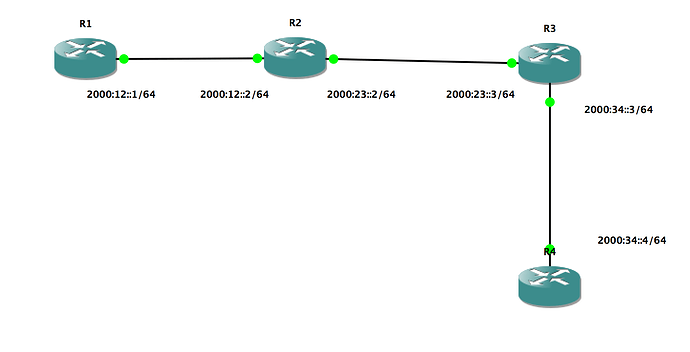I have a strange problem on a GNS3 simulation. I configure the IPv6 addresses shown on the routers.
R1 can not ping R3 (2000:23::3) as expected.
I enable RIPng on R1 interface 0
I enable RIPng on R2 interface 0
R1 still can not ping 2000:23::3 as expected
I enable RIPng on R2 interface 1 (RIPng is not enabled on R3; in fact ipv6 unicast-routing is not enabled on R3)
Now R1 can ping 2000:23::3 !!!
R1#sh ipv6 route rip
IPv6 Routing Table - 5 entries
Codes: C - Connected, L - Local, S - Static, R - RIP, B - BGP
U - Per-user Static route
I1 - ISIS L1, I2 - ISIS L2, IA - ISIS interarea, IS - ISIS summary
O - OSPF intra, OI - OSPF inter, OE1 - OSPF ext 1, OE2 - OSPF ext 2
ON1 - OSPF NSSA ext 1, ON2 - OSPF NSSA ext 2
R 2000:23::/64 [120/2]
via FE80::CA02:5FF:FEB7:0, FastEthernet0/0
R1#
Now from R3
R3#sh ipv6 route
IPv6 Routing Table - 6 entries
Codes: C - Connected, L - Local, S - Static, R - RIP, B - BGP
U - Per-user Static route
I1 - ISIS L1, I2 - ISIS L2, IA - ISIS interarea, IS - ISIS summary
O - OSPF intra, OI - OSPF inter, OE1 - OSPF ext 1, OE2 - OSPF ext 2
ON1 - OSPF NSSA ext 1, ON2 - OSPF NSSA ext 2
C 2000:23::/64 [0/0]
via ::, FastEthernet0/1
L 2000:23::3/128 [0/0]
via ::, FastEthernet0/1
C 2000:34::/64 [0/0]
via ::, FastEthernet1/0
L 2000:34::3/128 [0/0]
via ::, FastEthernet1/0
L FE80::/10 [0/0]
via ::, Null0
L FF00::/8 [0/0]
via ::, Null0
R3#ping 2000:12::1
Type escape sequence to abort.
Sending 5, 100-byte ICMP Echos to 2000:12::1, timeout is 2 seconds:
!!!!!
Success rate is 100 percent (5/5), round-trip min/avg/max = 12/18/28 ms
HOW can R3 ping R1 without a route ???
ipv6 CEF is not running on R3
R3#sh ipv6 proto
IPv6 Routing Protocol is "connected"
IPv6 Routing Protocol is "static"
R3#
